METHODOLOGICAL GUIDE
AND TRAINING COURSE PLAN
FOR ADULT EDUCATORS
Methodological guide
TABLE OF CONTENTS
- INTRODUCTION
- NEEDS ANALYSIS
- DIDACTIC PRINCIPLES
- TRAINING PROGRAMME
- TOOLS
- HOW TO CREATE A PROBM 2 TRAINING COURSE
1. INTRODUCTION
“Understanding and Developing Business Models in the Globalisation Era”, is an Erasmus+ Project which derives from the fact that every year, more and more enterprises are established, but less than 40% of them survive the first 5 years. The main problem is that many entrepreneurs-to-be do not value the power of business models and seem not to pay enough attention to this stage of company creation.
In recent years, European and worldwide markets have suffered from significant and sudden changes due to different processes, for example, globalisation, European integration, ICT development, the global economic crisis and the COVID-19 pandemic . These elements instigate change in the business strategies and business models of companies. This change becomes even more necessary where small and medium enterprises are concerned, because they are more exposed to the loss of competitiveness coming from market changes. The interactions between companies and other market players are considered as key factors in developing successful businesses (Mele, Russo-Spena & Colurcio, 2010) and in order to highlight these elements, a clear model is crucial to define a correct strategy.
The ProBM 2 project is a continuation of the ProBM project “Understanding and Developing Business Models” (ERASMUS+), in which the partners developed a simple and helpful compendium of business models for present or future entrepreneurs.
This compendium provides the basis to prepare an educational offer in the form of a training programme (on-line and offline) for adult educators and training providers, which could be used in order to educate entrepreneurs and other adults interested in gaining or extending knowledge and skills in the area of business models.
The main objective of the ProBM 2 project is to increase the skills and knowledge of adult educators and training providers in teaching business models. Acquired knowledge and skills will directly contribute to the design and use of a good business model by the beneficiaries (the adults wishing to undertake business activity or already having a business) for their implementation in their present or future enterprises.
This methodology guide and training course plan is aimed at giving adults a useful tool to employ all the training material provided by the ProBM 2 training course, especially the use of digital tools and resources offered by the course.
This guide is structured as follows:
– A description of the outcomes of the needs analysis, describing the current situation and the specific needs of the sector about the employment of the Business Model Canvas.
– The didactic principles which inspire the training course, reflecting the attention dedicated to the learner and their role in the active process of learning.
– The structure of the training programme, with an overall look at the training plan and its features, followed by a list of the ProBM 2 training modules.
– Finally, the instructions to correctly apply the digital resources created for the course. What do they offer and how are they used to broaden learners’ knowledge, skills and competences?
2. NEEDS ANALYSIS
The first phase of the project involved a questionnaire which was designed to gather information about the knowledge, understanding and use of business models in practice. The results were used for the development of the business models training programme for entrepreneurs and adult educators. Those eligible to participate included directors, entrepreneurs, business owners, business managers, heads of business or heads of human resources, who are involved with managing microenterprises which have been in operation for a minimum of 5 years. The research gathered responses from 5-11 respondents in each partner country, each of whom completed a survey about business models. The questionnaires were conducted electronically (via e-mail, Skype, Google Drive) and face-to-face.
Based on the results obtained from surveys, it can be stated that entrepreneurs from partner countries have some basic knowledge about what business models are (94,55% of interviewees answered that they know what a business model is), but only 43,64% of the entrepreneurs have heard of the Business Model Canvas before. Almost 100% of the interviewees recognized the importance of the development of a business model in contributing to the success of a company and how a business model improves the situation of a business or a company in the market. They also stated that a business model is crucial in reducing barriers or to improve their own business. Moreover, they listed a series of benefits deriving from the good use of business models:
-
- Plan for growth
- Improvement of operational effectiveness
- Increasing Profitability and Efficiency
- Financial Sustainability
- Unique Reputation in the Marketplace
Despite their recognition of the role of the application of business models in companies, only slightly above half of the entrepreneurs interviewed (50,91%) applied business models within their companies. The rest (49,09%) admitted that they did not apply business models because they did not know how to use them or they indicated other reasons, such as: Early stage of business development and its specifics; Lack of knowledge of the management about this topic; The focus of the company is mainly on revenue streams, so not much emphasis has been placed on other elements of the BM.
As the Business Model Canvas (BMC) is considered to be the easiest and most popular tool for creating a business model, there is a need to increase awareness and teach entrepreneurs how to use the Business Model Canvas, because less than half of respondents knew what the BMC is, and even less interviewees claimed that they did not use business models in their companies.
3. DIDACTIC PRINCIPLES
The following are the didactic principles that should be used and which could be very useful for trainers while implementing the ProBM 2 training material. Through the combination of online training tools and a correct application of the following didactic principles, it should be easier to achieve the training aims of the ProBM 2 training course.
The core of the training model should be a Learner-Centred Approach
Adult learners perceive learning as valuable if there is a reason for it, such as being relevant to their personal and professional growth. This is why it is crucial that professionals design and present relevant and task-oriented material, always tapping into learners’ interests and fulfilling learning needs. In order to do so, the focus of the learning process should be the learners and their background, interests and questions. They should be able, to a certain extent, to decide what and how they want to learn. Trainers should use a bottom up strategy that includes, for instance, the working experience of the target group. Educators should employ models that enhance the learning process linked to the reality of the learners. A space for self-directed learning processes and a continuous monitoring of learners’ engagement should be created. It should be a space of participation where learners are involved as much as possible. Trainers should be aware of the learners’ motivations, expectations, learning needs, and preferences. Trainers should encourage collaboration, opinions, and discussion and ask for feedback on learning and tools provided so that the learner is valued and feels central to the process.
The didactic approach should be based on Autonomy/Active Learning/Experiential Learning
Adult learners benefit from a more self-directed approach, rather than an instructor-led approach. This means that trainers need to create a learning path that can be self-managed by the learners. Encouraging curiosity, creating opportunities for it to manifested in questions, exploration, experiments, problem-solving, engaging in situations, discussions and discovery are all actions to undertake in order to stimulate people’s natural tendency to learn through exploration. Usually, real life examples and links to the real world are the most effective methods to encourage the learners’ autonomy, e.g., case studies, discussions, group work and problem solving. Adults need the know-how to develop skills and perform better. Professionals must acknowledge and leverage the adult learners’ expertise and knowledge in the training context, so as to integrate the learners’ experience as an active part of the learning process. Finally, the training material has to be intuitive and clear, written in clear language and directed towards core concepts.
The target group motivation is a key factor for the success of the learning
Training modules are based upon learning outcomes identified from the results of the needs analysis. Adult learners’ motivation is mainly driven by internal motives. Each person develops their own methods of motivation based on their own reasons, for example, professional development or personal growth. Adult learners are more inclined to learn when they perceive new concepts, skills, and competences as relevant and applicable in real-world situations. In order to create significant change in skills, attitudes, and competences, it is necessary to assess the learning needs of the trainees. Furthermore, it is crucial to design a learning process that fosters the continuous improvement of the newly acquired competences after the training has been completed. Blended learning and follow-up tasks ensure that what has been learned is transferred into the learners’ lives and real situations.
Digital Technologies and ICT tools should be considered as fundamental resources for adult learning
Multisensory environments actually stimulate learning. People remember more when they see and hear information at the same time, as in multisensory presentations that stimulate creativity and problem-solving skills. As far as in many other aspects of everyday life, technology and its use play a fundamental role in this case. It helps the training material to be interactive and accessible to everyone, so it should be exploited to the furthest extent to be really useful. It can be implemented by using multimedia presentations, animations, exhibitions, demonstrations, relevant music, sounds, textures. Visuals are even more effective than text. A picture allows the brain to associate meaning much faster, and to recover that meaning faster too.
4. TRAINING PROGRAMME
Training course
The ProBM 2 training course is aimed at providing additional resources on the comprehension and use of the Business Model Canvas. The focus is on the business model as an additional tool in order to improve business management and an additional resource for trainers who work in the area of entrepreneurship.
According to Osterwalder, Pigneur and Tucci, a unique definition of the term ‘business model’ does not exist. The literature presents many different definitions, some are general definitions, others describe various elements and create typologies of models, while other definitions present specific examples of business models of companies that operate on the market (ref. Clarifying business models: Origins, present and future of the concept – Article in Communications of the Association for Information Systems, June 2010).
The ProBM 2 training course focuses on the following definition given by Osterwalder, Pigneur and Tucci:
The training course is composed of training modules created to enable learners to eventually be capable of using business models in practice and to improve understanding in this area.
By developing the training material and putting it into a digital context, the objective of the ProBM 2 training course is to train adult educators and training providers on how to educate entrepreneurs and other adults who are interested in gaining or extending knowledge and skills in the area of business models. The training material and modules are developed according to identified Learning Outcomes described in terms of knowledge, skills and competences for each module. A learning outcome is a statement of what a learner knows, understands and is able to do on completion of a learning process.
Knowledge, skills and competence:
Knowledge represents the body of facts, information, rules, etc., related to a specific field of study. Skills represent the know-how, the application of the knowledge. Competence is the ability of using skills and knowledge in one’s professional or personal life.
Defining clear learning outcomes leads to the effectiveness of the training content.
Target group
The target group includes adult educators and training providers willing to teach business models as one of the elements of an entrepreneurship or business training programme, entrepreneurs-to-be, and other adults (as beneficiaries), who wish to extend their knowledge and skills on business models.
Training modules
The ProBM 2 training course is structured in 11 modules for a total of 41 learning hours. Each module has been developed according to the same structure which is outlined below. The first four parts are dedicated to introducing the learner to the module’s main content, the purpose, the learning outcomes and keywords. Then, the main content is developed, together with examples and good practices implemented by different companies and exercises to reflect on the content of the module. At the end of each module the learner will find a self-assessment activity to evaluate whether he/she has achieved the foreseen learning outcomes, together with references and external links for those who are interested in exploring further content on the topic.
The following table guides the adult educator in the development of new training modules in line with what has been developed in the ProBM 2 training course.
| Introduction | Provide a short summary of the training module |
| Purpose | Describe the purpose of the training module |
| Learning Outcomes |
Describe the expected learning outcomes after a learner takes this training module. Τhe learning outcomes are divided into three categories.
|
| Keywords | Provide the key points / keywords which highlight the main items of interest from the module |
| Main Body | Content |
| Examples and good practices | |
| Exercises | |
| Self-evaluation activities | |
| References and external links |
List of training modules:
The 11 training modules developed within the ProBM 2 project are listed below to provide adult educators with a quick general overview on the content of each module and on the learning outcomes. The table shows the title of each module, the expected duration (in approximate learning hours), a short description and the learning outcomes.
| Module | Title | Duration (Learning Hours) | Short description | Learning outcomes |
| 1 | Introduction | 1 | This module provides an overview of the Business Model, focusing on its definition, classification according to the market relationship, application and benefits. Its aim is to provide a detailed description of each area which constitutes the Business Model. |
|
| 2 | Customer Segments | 4 | The purpose of this module is to help you understand what Customer Segments are and how you can work with them in your business plan. |
|
| 3 | Value Proposition | 4 | The aim is to comprehend and identify Value Propositions for potential clients. |
|
| 4 | Channels | 4 | This module aims to provide theoretical and practical information, including examples and exercises, related to the relevance and use of Channels in the Business Model Canvas, how these should be applied and how organisations (established and start-ups) can capitalise on possibilities related to communication via various channels. |
|
| 5 | Customer Relationships | 4 | The purpose of this module is for learners to understand the value of Customer Relationships and to explore how Customer Relationship strategies may be structured and integrated into a company’s business model. |
|
| 6 | Revenue Streams | 4 | This module aims to provide theoretical and practical information, including examples and exercises, related to the relevance and use of Revenue Streams in the Business Model Canvas, how these should be applied and how organizations (including start-ups) can capitalise on possibilities. |
|
| 7 | Key Resources | 4 | The purpose of this module is to understand what the Key Resources of a business model canvas are, and how you can work with them in your business plan (option, categorization, development, etc). |
|
| 8 | Key Activities | 4 | The purpose of this module is to understand what the key activities are and how you can work with it in your business plan. |
|
| 9 | Key Partnerships | 4 | The purpose of the Key Partnerships module is to support managers to identify strategic partners for the correct functioning of the business and to foster the creation of joint collaboration. |
|
| 10 | Cost Structure | 4 | The purpose of the Cost Structure module is to support managers to identify the two main categories of cost and to calculate total costs. |
|
| 11 |
Citizenship and Professional Values |
4 | The purpose of this module is to supply adult educators and training providers with basic knowledge on what Citizenship and Professional Values mean and how they can be fruitfully merged into a business model. |
|
5. TOOLS
The training course is implemented on a digital platform that employs several interactive activities and resources. The platform can be accessed at: https://probm2.cti.ugal.ro . The ICT tools are the most relevant resources for an extensive and effective training of the target group to reach the foreseen ProBM 2 training course objectives.
Modules
All training modules available on the ProBM 2 educational website, are divided into three sections: Learn, Teach and Exercises & Quizzes.
The “Teach” button leads to online interactive presentations for each module which are conceived for trainers and adult educators in search for great engagement in their students while increasing their knowledge on the subject. Similarly, the “Learn” button leads new entrepreneurs and adult learners through ProBM 2 themes and materials gradually, in a text format.
The “Exercises & Quizzes” section is for both target groups to be used in class and independently online.
This division addresses different learning styles of the aforementioned target groups when absorbing, processing and retaining the same information.
The training material is also easily downloadable in a PDF format in both sections.
Interactive presentations
The multimedia presentations of the content focus on the topic of each module of the training program, ensuring the continuity with the goals of the training path. The presentations include a theoretical background, examples, exercises and references connected to the topic itself.
Quizzes and exercises
Online quizzes and exercises are provided to adult educators for each of the modules. Different exercises are offered to assess the knowledge of the course participants:
- Open questions to be used as self-assessment or peer learning within a group;
- Online questions with possible multiple choice or true/false answers, or open-ended questions to answer.
All the material is available for personal computers, tablets and smartphones. The online platform is freely accessible at any time by the user.
Tools
In this section you can find several digital tools that will support you in your learning path about Business Models.
Business Model Canvas
The ProBM 2 template of BM Canvas provides the user the structure of a business model canvas in one single page. This Business Model Canvas framework can be used by the user to create his/her own Business Model in the future.
This is an open tool to be used by all entrepreneurs and future entrepreneurs interested in starting a new business.
Financial calculator
The ProBM 2 Financial calculator allows the users to estimate the financial profitability of a business idea. In order to calculate if the business activity is profitable, and after how many years costs of investments will be recovered, the user should:
- Have a clear idea of the business activity to be launched;
- Be able to estimate the investment costs
- Identify the core risks of the business activity
- Identify the fixed costs per year connected to the business activity
- Identify the variable costs per service of the business activity
- Calculate the break-even point
After having carried out the steps above, the user will be able to make financial projections: calculate the Net Present Value (NPV), the Internal Rate of Returns (IRR), and estimate the payback period of the business activity.
The financial calculator can be accessed here: https://probm2.cti.ugal.ro/site/en/financial-calculator/
This is an open tool to be used by all entrepreneurs and future entrepreneurs interested in calculating business’ profitability. In module 10 users can also find various exercises developed using the financial calculator tool.
Business Model Canvas Editor
The BM Canvas Editor is an open digital tool that can be used by the user to create his/her own business model. It can be filled in with all the information by the user directly through the platform and, once completed, the document can be easily downloaded.
Competence Map
The ProBM 2 Competence Map supports future entrepreneurs and managers to become more aware of skills and competences required by the market in the field of business. For each module two aspects are described: learning objectives and learning outcomes (in terms of skills and competences to be reached). The Competence Map is an open tool and can be downloaded as a pdf document directly through the platform.
Training Tool
If you click on “training tool” you can access the ProBM 2 learning management system. The adult educator can use this online learning environment and change or adapt the available material according to the target group. More specific information is provided in the section below.
6. HOW TO CREATE A PROBM2 TRAINING COURSE
If you are an adult educator interested in offering the ProBM 2 course to adults, in this section you will find some guidelines and tips on how to use the material.

1. Course Welcome or Opening
This first welcoming phase is needed to get to know each other, explore participants’ expectations/ learning needs/existing competencies to build on. During this session it is advisable to provide information about and access to the different course modules.
The welcoming activities can be done through the outline of the ProBM 2 project website (http://businessmodels.eu/02/index.php/en/). Here you can find the purpose of the project, news about the topic and the reasons why the course has been created. It is useful as an introduction to the course setting, as it presents the context of the training course and sets the tone of the contents for the learners.
The project website provides information about the course modules and direct access to the different elements. This section allows trainers to support learners with information on how to navigate the course, what to expect and how to prepare for the learning experiences.
2. Instructions
This phase aims to support the learner to become familiar with the module structure and contents, so that they know how to begin. You can use the “Introduction” of each module where the structure, a brief description, the purposes and the learning outcomes are presented. Keywords employed within the module are also presented here. This part can be used to assess and analyse participants’ prior knowledge on the topic.
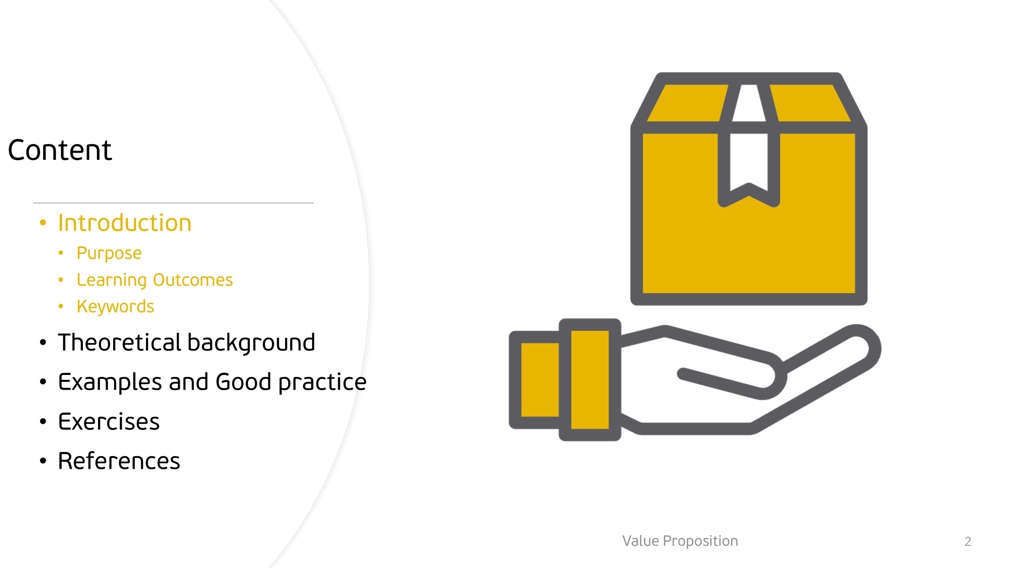
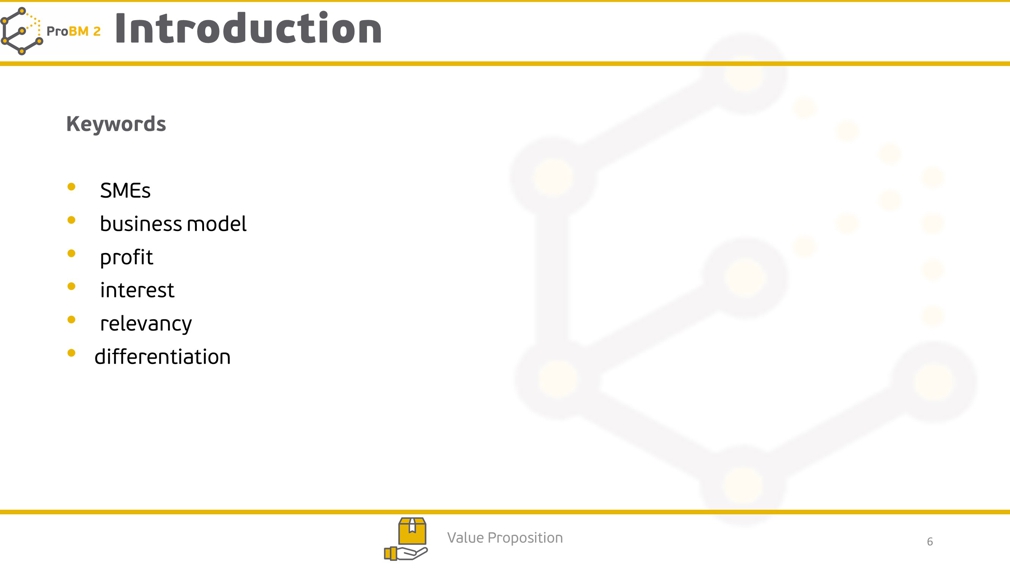
3. Learning Outcomes
Learning outcomes are a key resource for learners to know what to expect from the module and focus on the results of the learning activity.
ProBM 2 learning outcomes are listed in the “introduction” section of each module, to be presented to learners.
If the online module is part of a broader training, make sure it is clear how the learning outcomes fit in with the general training goal.
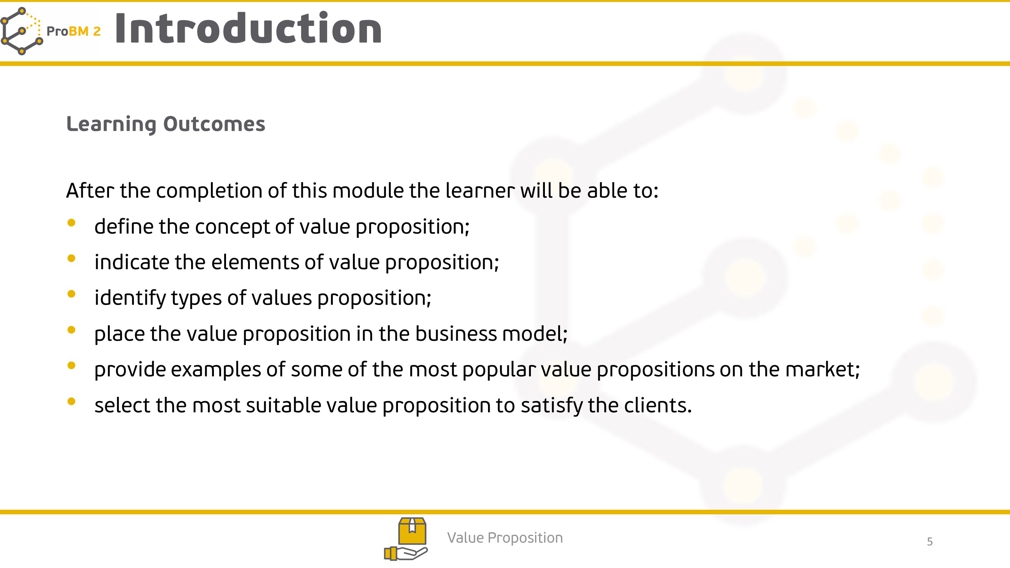
4. Content
This is the main and richest part of each module. The contents are presented in different formats, using charts, diagrams, bullet points, text and external links. Contents are divided into two parts: the theoretical background, where general rules, theories and explanations are given, then examples and good practices are presented in order to give practical evidence of the theory presented.
The theoretical part aims at providing basic theoretical notions on each subject, while case studies aim at giving the learners the practical point of view and offer an insight on the application of theories. The two parts are divided into two different sections: “Theoretical background” and “Examples and good practices” on the ProBM 2 website.


5. Practice Activities
These activities help participants to strengthen their skills and knowledge by applying the content they have learnt and reflecting on real cases.
“Exercises” are in a separate section in each module and these allow the learner to practice the presented theory and to achieve the foreseen learning outcomes stated at the beginning of the module.
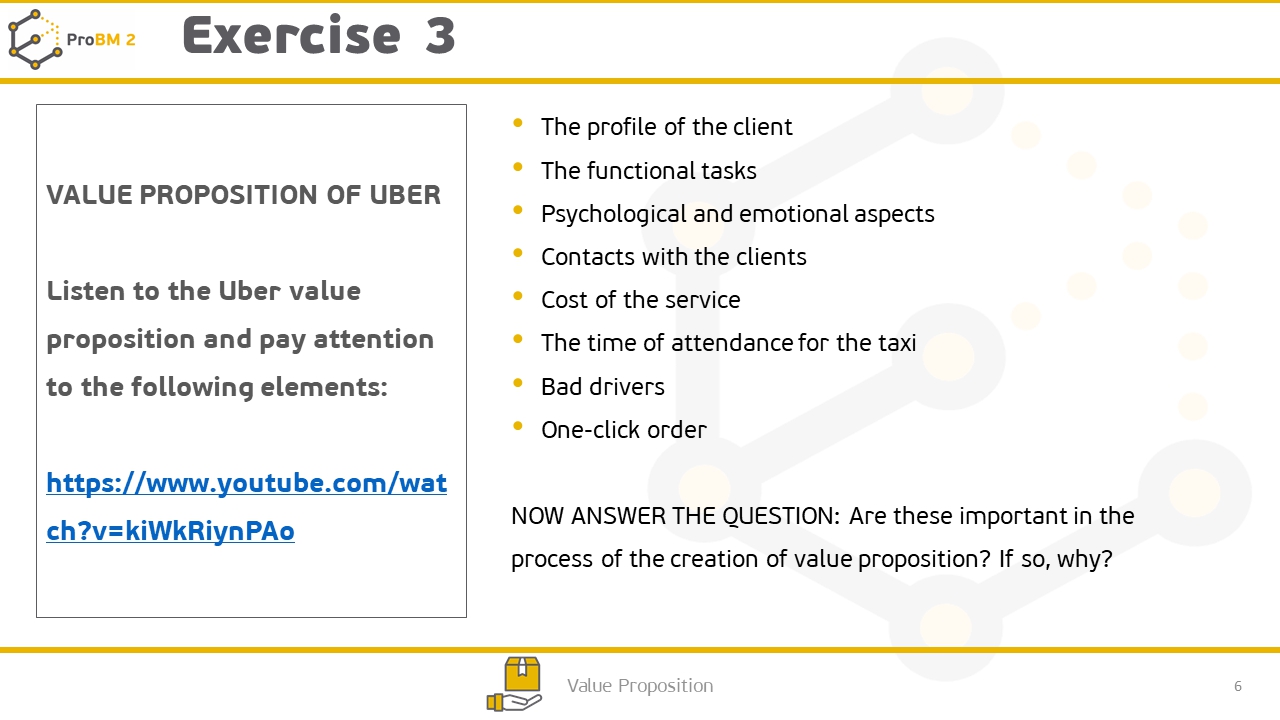
6. Knowledge Checks & Assessments
This section supports learners to assess their knowledge in relation to the stated learning outcomes. The self-assessment includes quizzes for each module. It contains 10 questions with possible multiple choice or true/false answers.
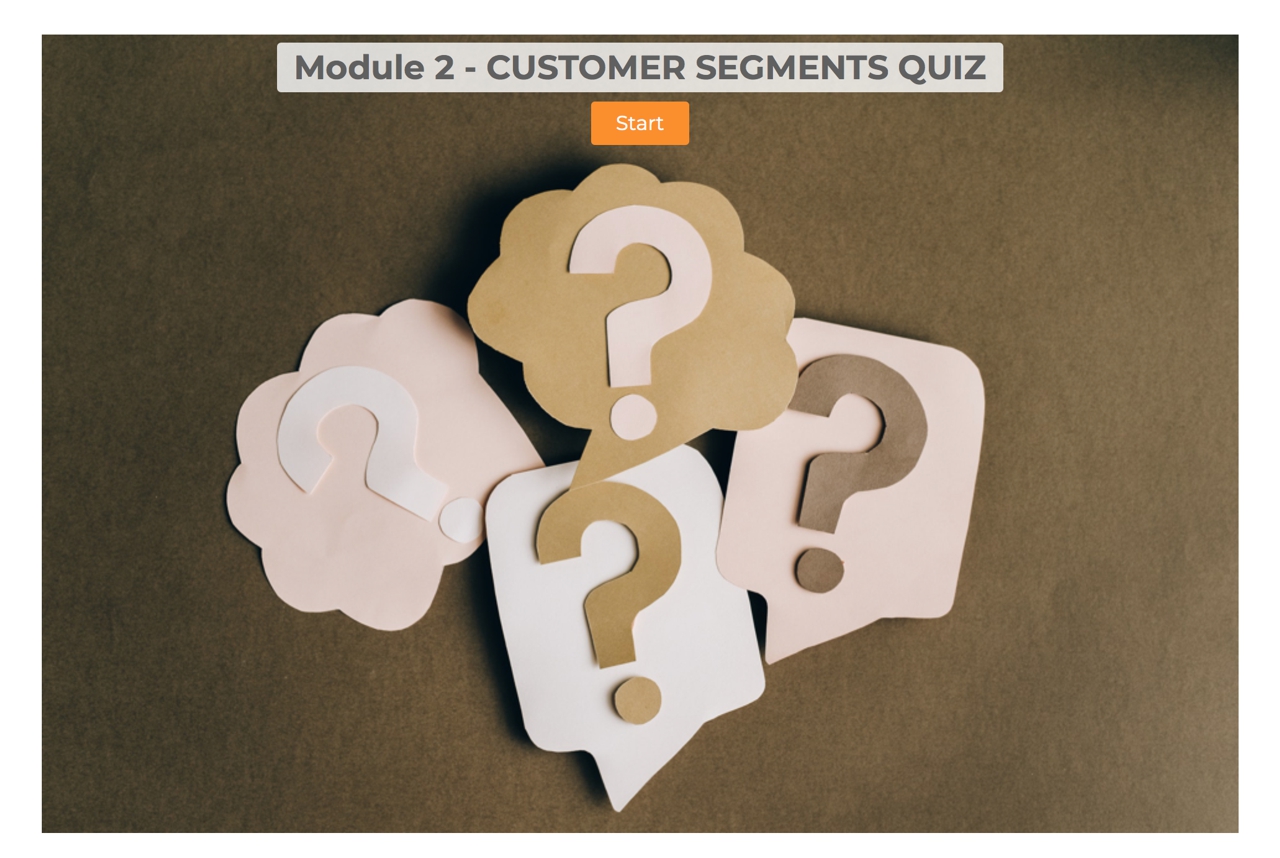
7. External references
In this last section, external links and references are listed, in order to offer further learning possibilities and examples related to the module.
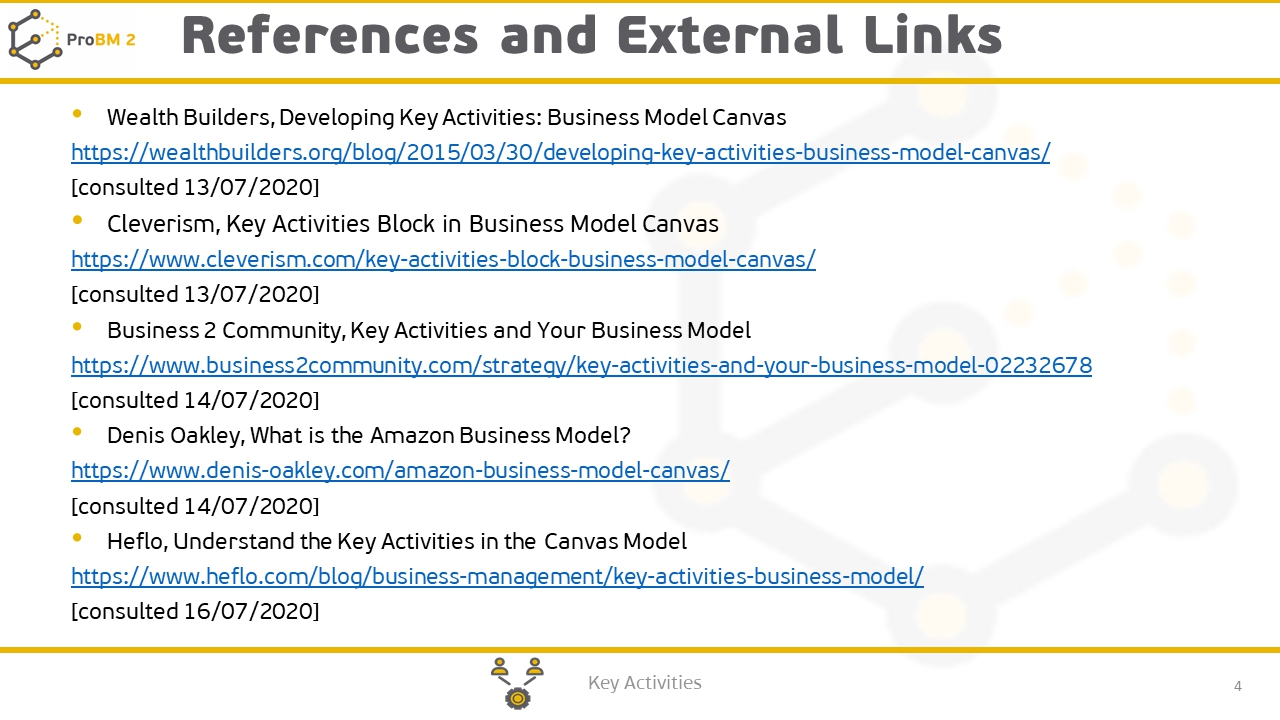
All editable training material is available on the project learning management system at: https://probm2-edu.cti.ugal.ro/.
The ProBM 2 learning management system consists of the following sections:
- INTRODUCTORY VIDEOS regarding Business Model Canvas.
- READING MATERIALS all the modules are provided in pdf format .
- SELF ASSESSMENT a set of exercises for a self-evaluation of the user.
- FINAL TESTS a collection of multiple choice questions to test your knowledge.
- DETAILED CASE STUDIES illustrating various companies business models.
All the material is available and easily downloadable from the learning management system and can be integrated in any other online environment.
For full access to the online environment the user first needs to create an account, choose a username and password and finally log onto the platform. Guests cannot access the course on the platform, thus the user needs to log in.
The learning management system also allows adult educators to set up groups and/or classes in order to keep track on the progress made and evaluate the different competences developed by the users.
Copyright @2021 – businessmodels.eu

